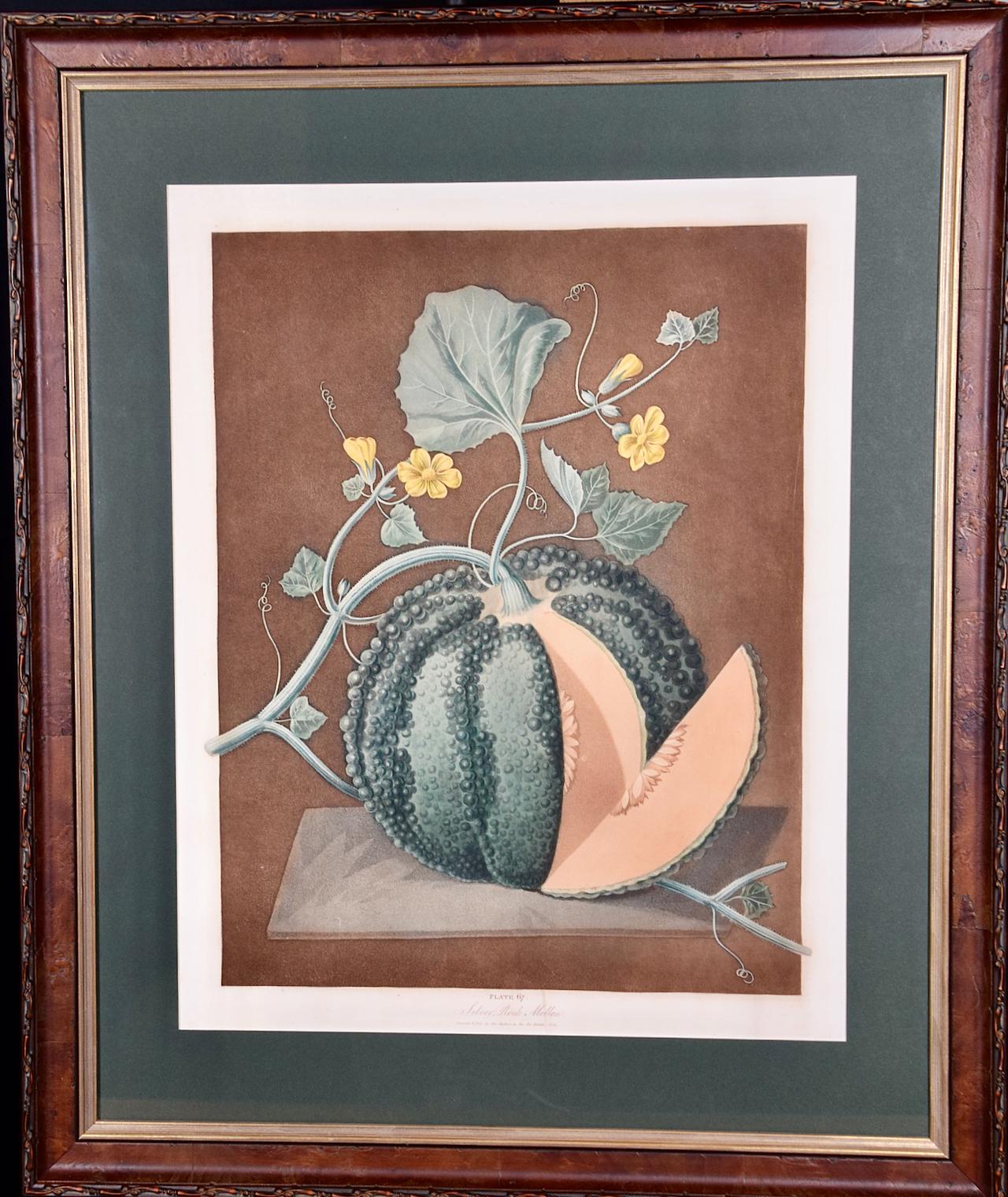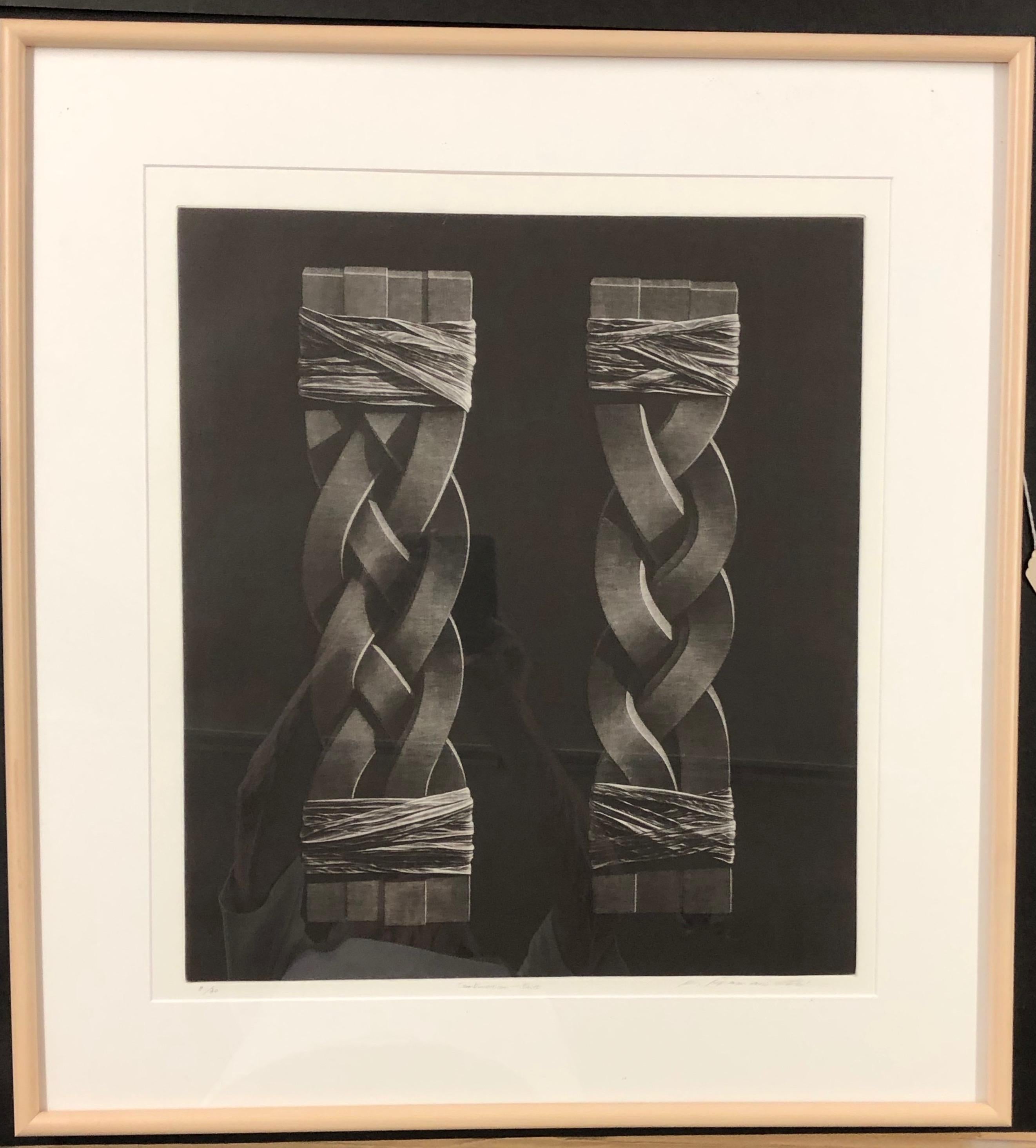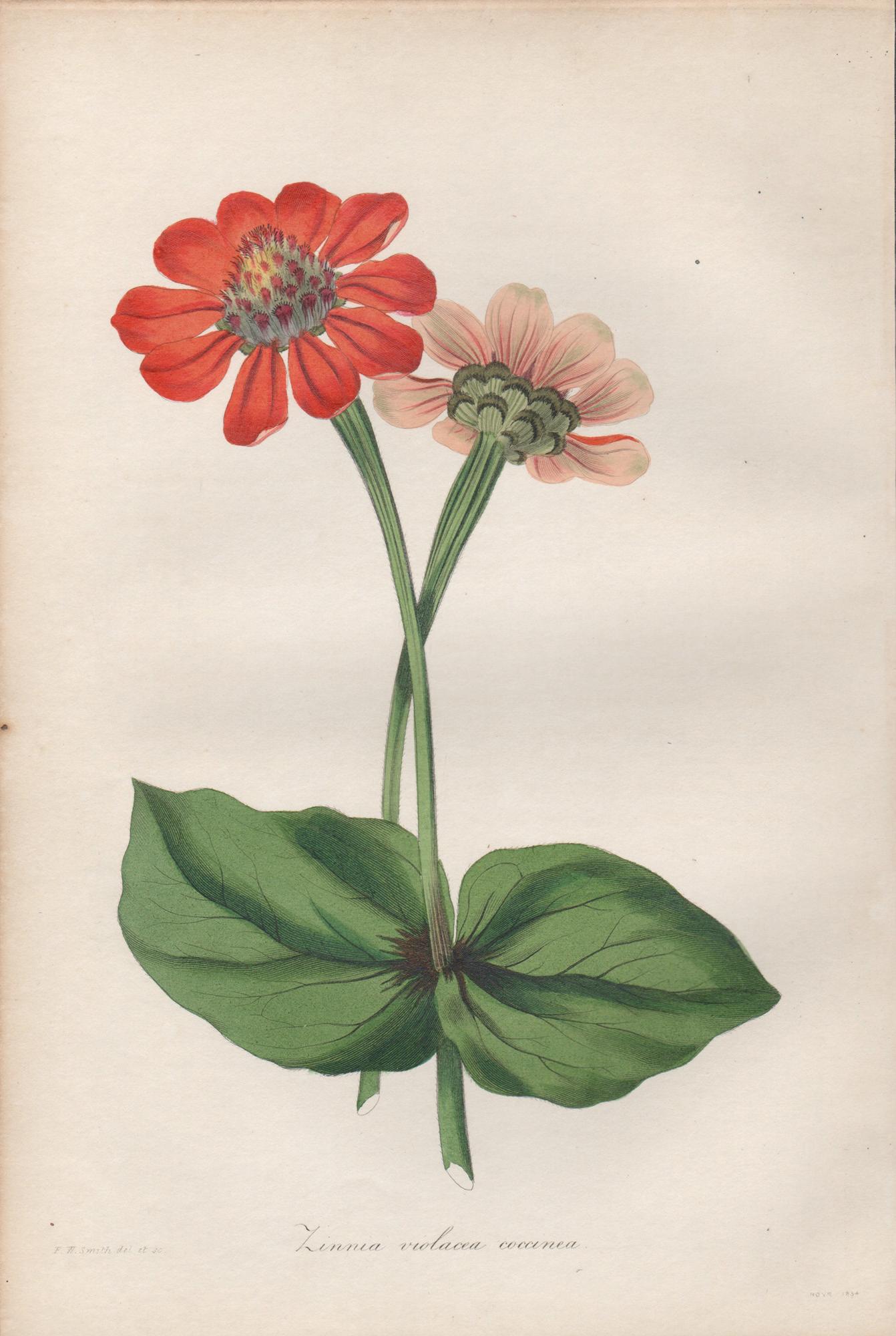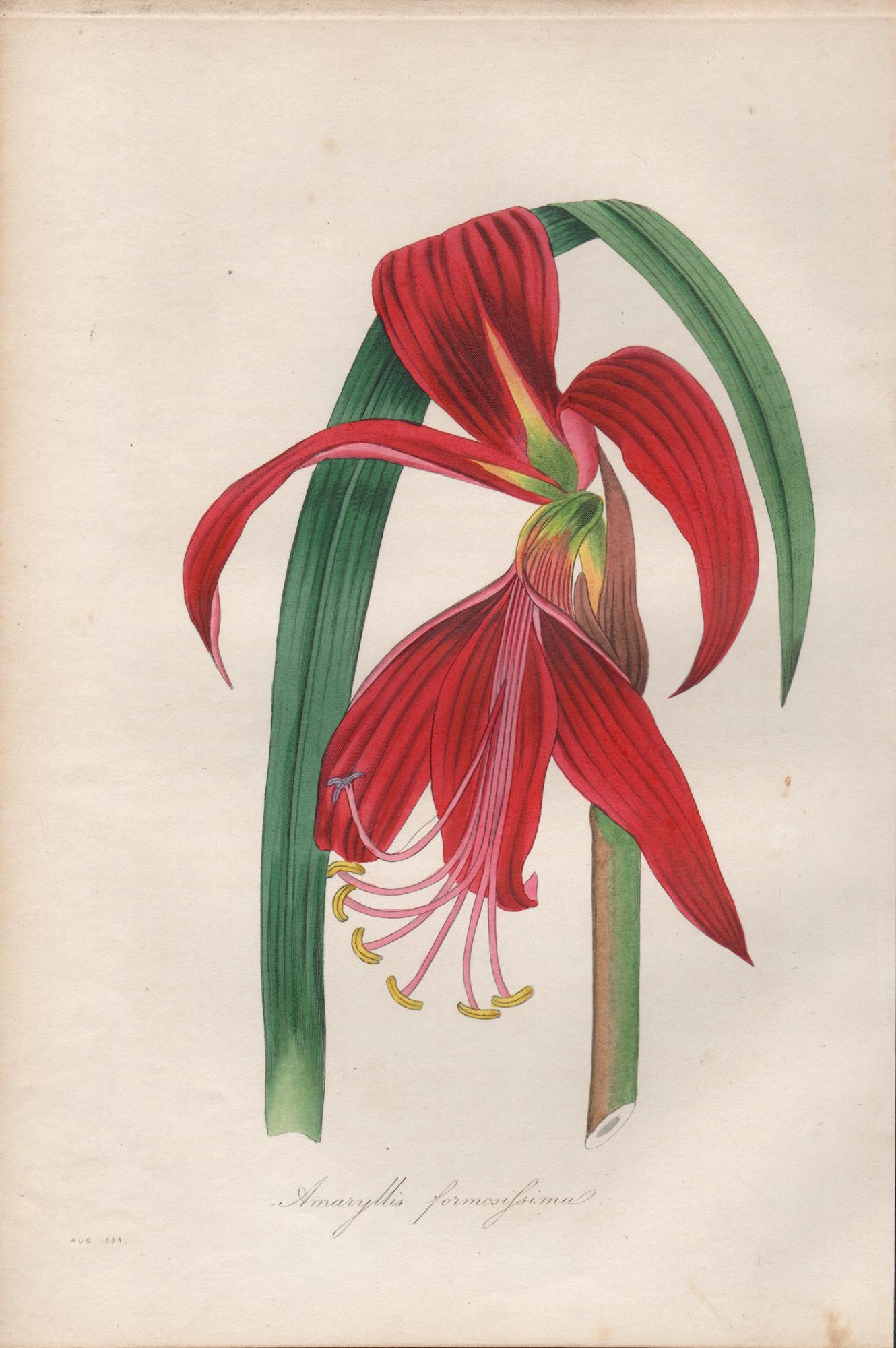Items Similar to Gladiolus strictifloras. Glayeul a fleurs droites
Want more images or videos?
Request additional images or videos from the seller
1 of 8
Pierre Joseph RedouteGladiolus strictifloras. Glayeul a fleurs droites
About the Item
Stipple engraving with color by Langlois after painter and botanist Pierre-Joseph Redouté (1759-1840), from Les Liliacées, published 1802-1816. Considered among jis best work, Redouté's largest and most ambitious work consisted of 486 engravings in 8 volumes and depicts all of the members of the lily family of plants including irises, tulips, orchids, amaryllis, and crocus.
Pierre-Joseph Redoute was one of the most celebrated botanical artist during the golden era of French botanical illustration, spanning the first four decades of the 19th century. Born in Belgium into two generations of artists, Redouté traveled to Paris as a young man where he met his first patron the wealthy botanist Charles Louis L’Heritier, who gave him work as an illustrator and instructed him in plant anatomy. He also became a protégé of Dutch artist Gerard van Spaendonck, a professor of flower painting at the museum of the Jardin du Roi, through which Redoute joined the museum staff and eventually succeeded Spaendonck after his death as “master of drawing.”
Introduced to court by L’Heritier, Redoute became the official court artist of Queen Marie Antoinette. He survived through the French Revolution and the Reign of Terror to attract another important patron, the Empress Josephine Bonaparte, who commissioned an extensive series of paintings after the ornamental flowers in her lavish gardens at Malmaison.
Later in life he became master of design for the Museum d'Histoire Naturelle. Although particularly renowned for his botanical exploration of roses and lilies, he turned to choosing to paint flowers purely for aesthetic value rather than scientifically documenting a full range of a species. This included those images depicted in the celebrated Choix des plus belles Fleurs. Over his long career, Redouté collaborated with the greatest botanists of his day and participated in nearly fifty publications, contributed over 2,100 published plates depicting over 1,800 different species, many never rendered before.
Redouté's gained recognition not only for his precise renderings of plants, but even more so for his work in stipple engraving and his innovation with the application of colors in the printing process. His renown is due to the remarkable quality of the prints made after his paintings, which brought his works to a wider audience during his lifetime and thereafter. Redouté’s refined technique capture the subtle delicacy of flower petals and foliage, most evident in his three great works, Les Liliacees (1802-1816), Les Roses (1817-1824), and lastly, Choix des Plus Belles Fleurs.
- Creator:Pierre Joseph Redoute (1759 - 1840)
- Dimensions:Height: 21 in (53.34 cm)Width: 14 in (35.56 cm)
- Medium:
- Period:
- Framing:Framing Options Available
- Condition:Water damaged wtih large stain, left bottom section and top edge. Tape residue along top edge. Horizontal crease across bottom width of page. Uneven right borders with some small tears along edges.
- Gallery Location:Mount Vernon, NY
- Reference Number:
About the Seller
4.1
Vetted Seller
These experienced sellers undergo a comprehensive evaluation by our team of in-house experts.
Established in 2020
1stDibs seller since 2020
161 sales on 1stDibs
Typical response time: 1 hour
- ShippingRetrieving quote...Ships From: Mount Vernon, NY
- Return PolicyA return for this item may be initiated within 14 days of delivery.
More From This SellerView All
- Environs de Babylone. Le Kaire. / Details des Quatre Faces d’un Obelisque TrouveLocated in Mount Vernon, NYCopperplate engraving on laid paper. This plate was created for Description de l'Égypte : ou, Recueil des observations et des recherches qui ont été faites en Égypte pendant l'expédition de l'armée française. [Description of Egypt...Category
Late 19th Century Still-life Prints
MaterialsEngraving
- Edfou (Apolllinopolis Magna.) / Elevation du Portique du Grand TempleLocated in Mount Vernon, NYCopperplate engraving on laid paper. This plate was created for Description de l'Égypte : ou, Recueil des observations et des recherches qui ont été faites en Égypte pendant l'expédition de l'armée française. [Description of Egypt...Category
Late 19th Century Still-life Prints
MaterialsEngraving
- Environs de Babylone. Le Kaire. / Details des Quatre Faces d’un Obelisque TrouvLocated in Mount Vernon, NYCopperplate engraving on laid paper. This plate was created for Description de l'Égypte : ou, Recueil des observations et des recherches qui ont été faites en Égypte pendant l'expédition de l'armée...Category
Late 19th Century Still-life Prints
MaterialsEngraving
- Thebes. Medynet-Abou / Coupes Transversales de la Cour et du Peristyle du PalaisLocated in Mount Vernon, NYCopperplate engraving on laid paper. This plate was created for Description de l'Égypte : ou, Recueil des observations et des recherches qui ont été faites en Égypte pendant l'expédition de l'armée française. [Description of Egypt...Category
Late 19th Century Still-life Prints
MaterialsEngraving
- Thebes. Medynet-Abou / Details d’un Pilier Caryatide et d’une Colonne du PeristyLocated in Mount Vernon, NYCopperplate engraving on laid paper. This plate was created for Description de l'Égypte : ou, Recueil des observations et des recherches qui ont été faites en Égypte pendant l'expédi...Category
Late 19th Century Still-life Prints
MaterialsEngraving
- Thebes. Qournah. / Elevation et Coupe Longitudinale du PalaisLocated in Mount Vernon, NYCopperplate engraving on laid paper. This plate was created for Description de l'Égypte : ou, Recueil des observations et des recherches qui ont été faites en Égypte pendant l'expédi...Category
Late 19th Century Still-life Prints
MaterialsEngraving
You May Also Like
- Silver Rock Melon: A Framed 19th C. Color Engraving by George BrookshawBy George BrookshawLocated in Alamo, CAThis is a 19th century colored aquatint and stipple engraving finished by hand entitled "Silver Rock Melon", drawn and engraved by George Brookshaw and published in London in 1812 as plate 67 in his 'Pomona Britannica; or, A Collection of the Most Esteemed Fruits'. It depicts a Silver Rock Melon still on the vine, but the melon lies on a heater green mat. A wedge of the melon has been dissected to reveal its inner anatomy, including the seeds. The melon skin is a heather and light green color, while the inner portions are a light peach color. The vine and leaves are shown attractive shades of light green and there are soft yellow flowers. The plant is displayed on a light brown textured background with shadows to impart 3-dimensionality. The scene is reminiscent of an engraving in an 18th century artistically stylized human anatomy atlas. There are wide white margins. The title and inscription lies within the lower border. This striking engraving is presented in a reddish brown decorative wood frame with a darker brown scroll-work outer trim and a gold-colored inner fillet and a thick heather green mat. The frame measures 25.75" high, 21.5" wide and 1.13" deep. It is glazed with UV conservation glass. There is a short thin vertical line of discoloration in the lower margin through the word "melon" and a tiny spot in the upper margin on the left. The print and frame are otherwise in excellent condition. There is a second Brookshaw engraving that is framed in identical moulding, although a slightly different size and a different color mat. t depicts a cluster of grapes. The two prints would make a striking display pairing...Category
Early 19th Century Naturalistic Still-life Prints
MaterialsEngraving, Aquatint
- White Hamburgh Grape: A Framed 19th C. Color Engraving by George BrookshawBy George BrookshawLocated in Alamo, CAThis is a 19th century colored aquatint and stipple engraving finished by hand entitled "White Hamburgh Grape", drawn and engraved by George Brookshaw and published in London in 1812 as plate 60 in his 'Pomona Britannica; or, A Collection of the Most Esteemed Fruits'. It depicts a cluster of pale green grapes still on the vine. The vine and leaves are shown in attractive shades of green and brown. The plant lays on a brown textured background with shadows to impart 3-dimensionality. The scene is reminiscent of an engraving in an 18th century artistically stylized human anatomy atlas. There is a light brown title rectangle in the lower center which is blank, suggesting this may be a more rare preproduction proof. There are wide white margins. This striking engraving is presented in a reddish brown decorative wood frame with a darker brown scroll-work outer trim and a gold-colored inner fillet and a thick light beige mat. The frame measures 26" high, 22" wide and 1.13" deep. It is glazed with UV conservation glass. There is a tiny spot in the lower margin on the left and another in the left margin. The print and frame are otherwise in excellent condition. There is a second Brookshaw engraving that is framed in identical moulding, although a slightly different size and a different color mat. It depicts a Silver Rock Melon. The two prints would make a striking display pairing...Category
Early 19th Century Naturalistic Still-life Prints
MaterialsEngraving, Aquatint
- Combination Knit, mezzotint by Katsunori Hamanishi, rope, Japan, black and whiteBy Katsunori HamanishiLocated in Santa Fe, NMCombination Knit, mezzotint by Katsunori Hamanishi, rope, Japan, black and white edition number 8/30Category
1990s Contemporary Still-life Prints
MaterialsMezzotint
- Zinnea violacea coccinea, antique botanical red flower engravingLocated in Melbourne, VictoriaEngraving with original hand-colouring. 1834. 230mm by 155mm. From Paxton's 'Magazine of botany and register of flowering plants' by Sir Joseph Paxton.Category
Mid-19th Century Naturalistic More Prints
MaterialsEngraving
- Azalea Pulchra, antique botanical flower engravingLocated in Melbourne, VictoriaEngraving with original hand-colouring. 1834. 230mm by 155mm. From Paxton's 'Magazine of botany and register of flowering plants' by Sir Joseph Paxton.Category
Mid-19th Century Naturalistic More Prints
MaterialsEngraving
- Amaryllis formosissima (Sprekelia, Aztec Lily), antique botanical engravingLocated in Melbourne, VictoriaEngraving with original hand-colouring. 1834. 230mm by 155mm. From Paxton's 'Magazine of botany and register of flowering plants' by Sir Joseph Paxton.Category
Mid-19th Century Naturalistic More Prints
MaterialsEngraving
Recently Viewed
View AllMore Ways To Browse
Queen Marie
Antique Botanical Illustrations
Stipple Engraving
Engraving Revolution
Antique Rose Plant
Le Roi A Paris
Dutch Garden Prints
Antique French Botanical Prints
Foliage Engravings
Louis Gerard
Print Bonaparte
Golden Staff
Botanical Print Rose
Still Life Roses Louis
Marie Antoinette Antique Art
Iris Plate
Marie Antoinette Painting
Golden Empress





